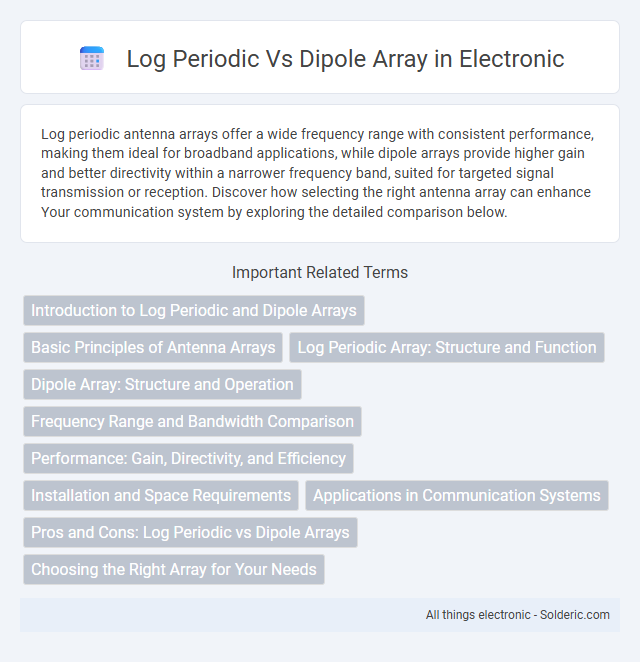Log periodic antenna arrays offer a wide frequency range with consistent performance, making them ideal for broadband applications, while dipole arrays provide higher gain and better directivity within a narrower frequency band, suited for targeted signal transmission or reception. Discover how selecting the right antenna array can enhance Your communication system by exploring the detailed comparison below.
Comparison Table
| Feature | Log Periodic Antenna | Dipole Array |
|---|---|---|
| Frequency Range | Broadband, covers wide frequency spectrum | Narrowband, centered around specific frequency |
| Design | Multiple elements of varying lengths and spacing | Multiple identical dipole elements spaced evenly |
| Gain | Moderate gain, typically 7-10 dBi | Higher gain possible by increasing number of elements |
| Radiation Pattern | Directional with moderate front-to-back ratio | Highly directional with sharper beamwidth |
| Impedance | Relatively constant over frequency range (50-75 O) | Impedance varies; often requires matching network |
| Application | Wideband communication, TV antennas, scanning | Point-to-point communication, radar, broadcasting |
| Complexity | More complex design and construction | Simpler element design, but array feeding can be complex |
Introduction to Log Periodic and Dipole Arrays
Log periodic and dipole arrays are fundamental antenna configurations widely used in radio frequency applications for their distinct radiation characteristics. Log periodic antennas feature a self-similar, tapered structure enabling wideband frequency coverage with consistent radiation patterns, making them ideal for communication and signal scanning over variable frequencies. Dipole arrays consist of multiple dipole elements spaced at specific intervals to achieve desired directional gain and beam shaping, commonly employed in applications requiring focused signals and enhanced directivity.
Basic Principles of Antenna Arrays
Log periodic antenna arrays consist of elements with lengths and spacings scaled logarithmically to achieve wide bandwidth and directional radiation patterns, while dipole arrays use uniformly spaced dipole elements with fixed lengths operating at specific frequencies to provide high gain and controlled beamwidth. The basic principle of log periodic arrays relies on frequency-independent performance through self-similar geometry, enabling consistent impedance and radiation characteristics across a broad range. Dipole arrays leverage constructive interference from multiple elements to steer beams and enhance gain, optimized for narrowband applications.
Log Periodic Array: Structure and Function
The log periodic array is characterized by a multi-element, self-similar structure where the element lengths and spacing follow a logarithmic progression, enabling wideband frequency coverage. Its design allows consistent performance across a broad spectrum by maintaining a nearly constant input impedance and radiation pattern. The array functions effectively in applications requiring frequency agility, such as communication and electronic warfare systems, due to its ability to operate efficiently over multiple octaves.
Dipole Array: Structure and Operation
A dipole array consists of multiple half-wave dipole antennas arranged in a specific geometric pattern to improve directivity and gain by constructive interference of radiated waves. Each element in the array is fed with a carefully controlled phase and amplitude to steer the radiation pattern and enhance signal strength in desired directions. Your antenna system benefits from this configuration by achieving higher resolution and improved signal-to-noise ratio compared to single-element dipoles.
Frequency Range and Bandwidth Comparison
Log periodic antennas exhibit a broad frequency range and wide bandwidth, making them ideal for applications requiring multi-octave operation from as low as 100 MHz up to several GHz. Dipole arrays, in contrast, provide narrower bandwidth centered around specific resonant frequencies, typically covering a fraction of an octave. The inherent design of log periodic structures allows continuous frequency coverage, while dipole arrays must be tuned for discrete frequency bands, limiting their operational bandwidth.
Performance: Gain, Directivity, and Efficiency
Log periodic antennas exhibit wideband frequency performance with moderate gain and consistent directivity, typically ranging from 6 to 9 dBi, making them suitable for applications requiring frequency agility. Dipole arrays offer higher gain and directivity, often exceeding 12 dBi, due to their constructive interference and element arrangement, enhancing signal strength and focus. Efficiency in dipole arrays generally surpasses that of log periodic antennas, as fewer elements and lower element spacing reduce resistive losses and improve radiation efficiency.
Installation and Space Requirements
Log periodic antennas require more complex installation due to their larger size and multiple elements arranged in a specific pattern, demanding ample space and precise alignment for optimal performance. Dipole arrays are generally easier to install and occupy less space as they consist of fewer elements arranged linearly or in simple configurations, making them suitable for constrained environments. Your choice depends on available installation area and the complexity you can manage for effective signal reception.
Applications in Communication Systems
Log periodic antennas offer wideband frequency coverage, making them ideal for applications requiring consistent performance over a broad spectrum, such as multiband communication receivers and spectrum analyzers. Dipole arrays provide higher gain and directivity, which enhances signal strength and reduces interference in point-to-point communication links and base stations. Your choice depends on whether you prioritize frequency agility or focused signal transmission in your communication system design.
Pros and Cons: Log Periodic vs Dipole Arrays
Log periodic arrays offer broad frequency coverage and consistent impedance, making them ideal for wideband applications, but their complex design and larger size can be drawbacks. Dipole arrays provide simpler construction and higher gain at specific frequencies, though they lack the frequency versatility of log periodic antennas. Your choice depends on whether you prioritize bandwidth flexibility or targeted frequency performance.
Choosing the Right Array for Your Needs
Choosing between a log periodic and dipole array depends on your application frequency range and directivity requirements. Log periodic arrays offer broad bandwidth and consistent pattern over a wide frequency range, ideal for applications needing frequency agility. Dipole arrays provide higher gain and narrow beamwidth suitable for fixed-frequency or narrowband communication systems, making them optimal when focused signal strength is crucial.
log periodic vs dipole array Infographic

 solderic.com
solderic.com